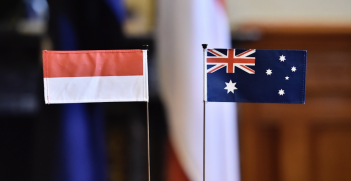A New Hope in Japan?

The sudden emergence of a new political party has complicated Japanese Prime Minister Shinzo Abe’s plans for an easy election. What will the post-election political landscape look like in Japan?
When Japanese Prime Minister Shinzo Abe called a snap election in late September, he probably saw it as an easy solution to a number of political problems. An early election meant that Abe could avoid discussing scandals in the Diet that were hampering his approval ratings. Meanwhile, a decisive victory would help him to burnish his leadership credentials ahead of his party’s leadership selection process.
With the main opposition, the Democratic Party of Japan (DP), in disarray, Abe also had every reason to believe that he would be on an extremely firm footing. Since then, however, the political ground has shifted dramatically, and Abe may find it difficult to find traction after the 22 October election.
The change in the political landscape was set off a few hours before Abe announced the snap election. With speculation about the announcement rife, the populist Governor of Tokyo Yuriko Koike moved to form her own party, the Party of Hope, catching Abe off guard.
There were murmurings that Koike was considering a run in national politics. However, Koike had neither the candidates nor the electoral machinery to take on Abe’s Liberal Democratic Party (LDP). Perhaps more than anything the snap election was also a play by Abe to pre-empt Koike’s entry into national politics.
Koike’s announcement has already sparked a completely unforeseen reordering of Japanese politics, which will make her party a serious force in the Diet. Days after the formation of the Party of Hope, newly selected DP leader Seiji Maehara, in a stunning display of ineptitude, successfully encouraged lawmakers in his own party to dissolve the DP and seek a merger with Koike’s new group. The Party of Hope has thus absorbed enough incumbent lawmakers to complicate Abe’s simple election plans.
Far from the simple merger Maehara appeared to envision, Koike has refused to accept former DP members that do not agree with her party’s policies. New recruits registering for the Party of Hope were required to sign a pledge supporting, for example, Koike’s stance on changing the nation’s pacifist constitution, which renounces war and outlaws the threat or use of force for the purpose of settling international disputes.
Despite fielding credible candidates, Koike is unlikely to achieve her stated goal of displacing the LDP as the ruling party. While the Party of Hope will almost certainly chip into LDP support and become the second largest party in the Diet, the ‘merger’ with former DP members was unpopular and after an initial boost in public enthusiasm her support has levelled out. A recent Yomiuri poll places support for the Party of Hope at 13 per cent, far behind the LDP at 32 per cent. As yet, 27 per cent of voters are undecided.
What do these dynamics mean for post-election political positioning and policy formation? Somewhat counterintuitively, given that her stated objective is to topple Abe, Koike’s gambit may strengthen the current prime minister’s position in certain ways. Koike has pledged to remain in office as governor of Tokyo in order to implement reform in ways that will inspire national politics. However, the spectacle of a figure outside of the house claiming to lead the opposition party may help Abe to undermine her legitimacy and work to solidify his own claim to strong leadership.
Also, as two conservative parties, there will be greater coherence between the LDP as the ruling party and Party of Hope as the main opposition force in important areas. Koike was previously an ally of the prime minister, even serving as defence minister from 2006 to 2007 in a previous incarnation of the Abe administration. There is thus little daylight between Abe and Koike on defence and foreign affairs.
Indeed, on revision of the constitution—which has not been changed since its promulgation in 1946—the two are practically on the same page. Both Koike and Abe favour robust revision to the article that outlaws the use of force in international disputes. However, Abe due to public distaste for extreme revision and the need to maintain the support of less enthusiastic coalition partners in the Upper House, has softened his stance on the issue. He now wants simply to insert language into the basic law that would clarify the legitimate existence of the nation’s Self-Defence Forces. Recognising political realities, Koike will likely also adjust her more hawkish preferences and lend Abe the votes to clear the parliamentary hurdle of a two-thirds majority that such revision requires.
Nevertheless, Koike’s gambit also has the potential to damage Abe after the election. An unexpectedly strong showing by the Party of Hope would rattle many in the LDP, even if the latter party remains in power.
Abe is already lowering expectations, stating that he will resign if the LDP and its current coalition partner do not capture a majority. For that to happen the ruling parties would have to lose more than 91 seats in the 465 seat chamber, a disastrous result. In reality, though, losing more than half that figure would prompt challenges to Abe’s leadership from within his own party.
If she is serious about dethroning Abe, Koike could then take advantage of such dissent by implicitly supporting anti-Abe factions within the LDP, damaging the prime minister’s ability to lead, even perhaps resulting in his downfall.
While she is a populist whose economic policy is as yet incoherent, Koike’s criticism of the LDP’s excessive economic stimulus and sluggish moves towards structural reform also has the potential to hit Abe where it hurts. In recent years, the absence of a credible opposition has allowed Abe to endure scandals that might have brought down less fortunate governments. Since coming to power in 2012, he has also weathered criticism over controversial security policies by constantly switching his focus to the economy after the policies have been implemented.
The economy is an area that, despite Abe’s mediocre results, has attracted less attention from the opposition. The relatively free ride, however, is now over. Time in opposition will give the Party of Hope the chance to formulate an economic strategy at the same time as it picks apart the LDP’s and criticises Abe’s weak leadership on reform.
Finally, the recent political realignment may ultimately prove unfavourable to both conservative parties. Some former DP members, who refused to join or were rejected by the Party of Hope, have formed the Constitutional Democratic Party (CDP). The CDP, due to its decision not to run candidates against former DP members is fielding only 78 candidates overall, hardly a stellar showing. Nevertheless, the CDP is now largely free of the ideological splits that dogged the DP. It could consolidate its vote in future elections, and with the LDP and the Party of Hope splitting the conservative vote, the CDP may eventually prove to be a more worthy and coherent challenger.
While it remains to be seen whether Abe’s move to call a snap election was the beginning of his own undoing, what is sure is that developments over the past few weeks have altered Japanese politics irrevocably.
Bryce Wakefield is a lecturer in area studies and international relations at Leiden University in the Netherlands. He is a specialist on Japanese politics and foreign policy.
This article is published under a Creative Commons Licence and may be republished with attribution.





